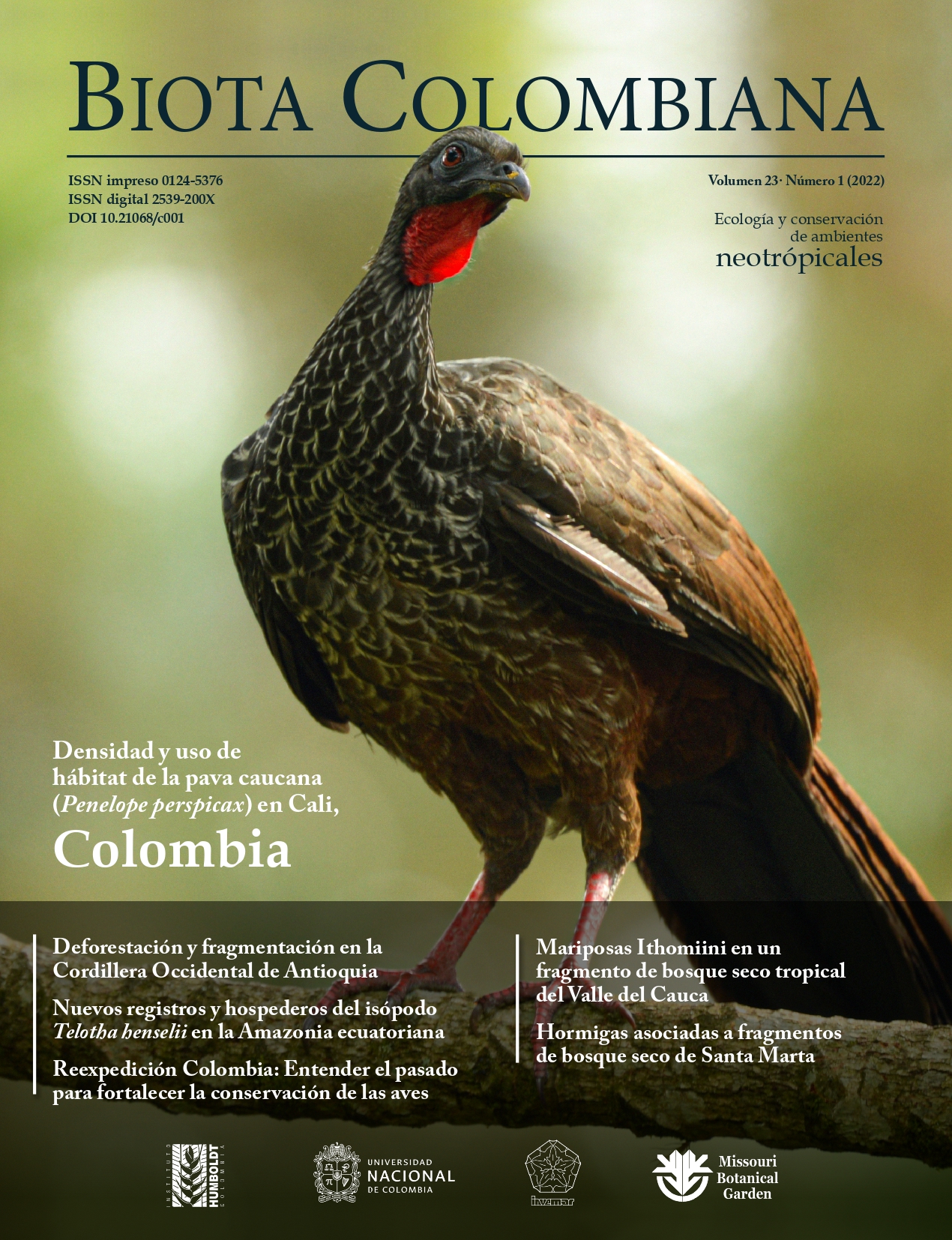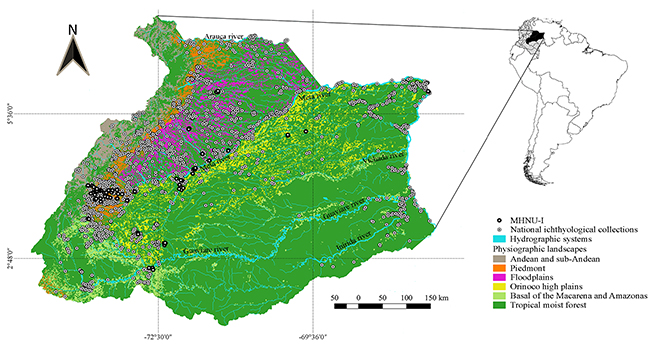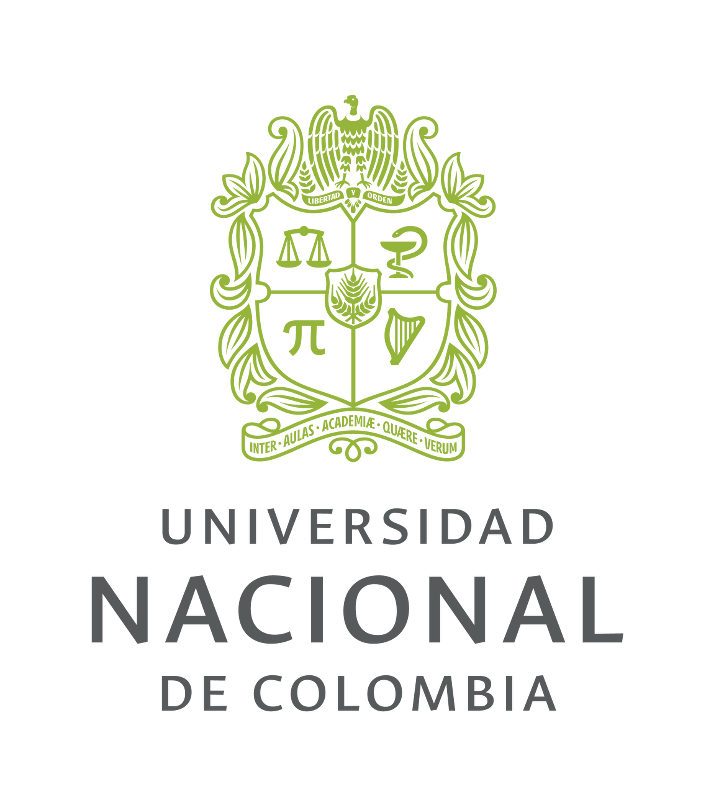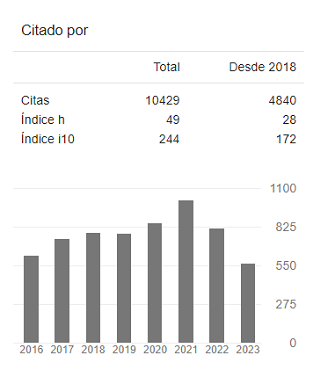Recibido: 26 de mayo de 2021; Aceptado: 6 de junio de 2021
Resumen
La colección ictiológica del Museo de Historia Natural Unillanos (MHNU-I) es la primera colección de peces de la Orinoquia colombiana. La colección alberga 78 806 especímenes en 3229 lotes, recolectados entre 2012 y 2019, que representan 10 órdenes, 42 familias, 170 géneros y 272 especies, provenientes en su gran mayoría de ambientes dulceacuícolas de la cuenca del río Orinoco (99 %), lo que representa el 37.3 % del número total de especies dulceacuícolas listadas para la zona hidrográfica del Orinoco. La colección contiene registros de 20 especies endémicas, dos especies en estado de amenaza (Potamotrygon orbignyi y Sorubim lima), y dos especies introducidas (Caquetaia kraussii y Oreochromis niloticus). La información contenida en este conjunto de datos permite consolidar a la colección ictiológica del MHNU, como uno de los puntos de referencia en cuanto a diversidad de peces de esta región.
Palabras clave:
Especies endémicas, Especies introducidas, Museo de Historia Natural, Orinoco, Peces dulceacuícolas..Abstract
The ichthyological collection of the Unillanos Natural History Museum (MHNU-I) is the first fish collection of the Colombian Orinoquia. The collection harbors 78 806 specimens in 3229 lots, collected between 2012 and 2019, representing 10 orders, 42 families, 170 genera, and 272 species, coming mostly from freshwater environments of the Orinoco River basin (99 %), representing 37.3 % of the total number of freshwater species listed for the Orinoco hydrographic area. The collection contains records of 20 endemic species, two threatened species (Potamotrygon orbignyi and Sorubim lima), and two introduced species (Caquetaia kraussii and Oreochromis niloticus). The information contained in this dataset allows consolidating the ichthyological collection of the MHNU, as a point of reference in terms of fish diversity of this region.
Keywords:
Endemic species, Freshwater fishes, Introduced species, Natural History Museum, Orinoco..Introduction
The Orinoco River basin that drains the Colombian territory is considered to have the second largest fish diversity in the country, with about 728 species, corresponding to 45.2 % of the national ichthyofauna (DoNascimiento et al., 2020). However, this richness is expected to increase, as some subsystems in the region are still poorly documented(Urbano-Bonilla et al., 2014; Usma et al., 2016; Urbano-Bonilla et al., 2018). The Colombian Orinoquia is recognized for its high diversity and for the processes of transformation of natural ecosystems, in particular the Andean-Orinoco foothills (Correa-Ayram et al., 2020). This area includes the sub-basins of the Ríos Ariari and Guamal, which have the greatest richness and endemism of freshwater fish species of Orinoquia (Zamudio, 2017), and its transformation may be causing the reduction or loss of biodiversity (Machado-Allison et al., 2010; Sánchez-Cuervo et al., 2012; Lasso et al., 2016).
Ichthyological collections in Colombia have played an important role in the documentation and conservation the country´s biological heritage (Maldonado-Ocampo, 2009). They contribute to initiatives such as the “Catalogue of the Freshwater Fishes of Colombia”, which is the result of the review, cleaning and standardization of biological records in the existing collections (DoNascimiento et al., 2018). At the same time, this type of resource has allowed academics and decision-makers to propose adequate strategies for the conservation of species and the sustainable use of ecosystems (e.g., declaration of zones under the Ramsar convention).
Currently, 31 institutions are recognized before the Registro Único Nacional de Colecciones Biologicas (National Register of Biological Collections) as housing freshwater and marine fishes. This paper synthesizes the information on fish diversity represented in the ichthyological collection of the Museo de Historia Natural Unillanos of the Universidad de los Llanos, the first and only institution of its kind in the Colombian Orinoquia.
Project data
Title. Updating and digitizing the ichthyological collection of the MHNU.
Name. Miguel Ángel Cortés Hernández (collection assistant), Elizabeth Aya Baquero (curator), Hernando Ramírez Gil (associate professor).
Sources of funding. Private donations (e.g., authors themselves).
Description of the study area. Colombia, mainly the Orinoco River basin.
Taxonomic coverage
Description.
The ichthyological collection of the MHNU includes 78 806 specimens, distributed in 3229 lots, representing 10 orders, 42 families, 170 genera, and 272 species. All species in the collection belong to the classes Actinopteri and Elasmobranchii. The four most representative orders are Characiformes, with 135 species in 1598 lots, Silurifomes, with 93 species in 1133 lots, Cichliformes, with 23 species in 279 lots, and Gymnotiformes, with 13 species in 114 lots (Table 1; Figure 1). 72.6 % of the records are identified to species level , 12.7 % to genus, and 4.1 % to family. In addition, 10.6 % of the records have an identification qualifier (i.e., aff. or cf.).
Table 1: Number of families, genera and species in the data set of the ichthyological collection of the Museo de Historia Natural Unillanos (MHNU-I), and their comparison with the richness of fishes present in the Orinoco River basin (values in parentheses) (DoNascimiento et al., 2020). Abbreviations: En, endemic species; Mi, migratory species; Or, ornamental use species; Fi, species for fishing use.
Figure 1: Taxonomic representativeness of cataloged records the ichthyological collection of the Museo de Historia Natural Unillanos (MHNU-I), Villavicencio, Colombia.
Categories
Kingdom. Animalia
Phylum. Chordata
Class. Actinopteri, Elasmobranchii
Order. Myliobatiformes, Characiformes, Gymnotiformes, Silurifomes, Synbranchiformes, Carangiformes, Cichliformes, Cyprinodontiformes, Beloniformes, incertae sedis.
Family. Acestrorhynchidae, Achiridae, Anostomidae, Apteronotidae, Aspredinidae, Astroblepidae, Auchenipteridae, Belonidae, Bryconidae, Callichthyidae, Cetopsidae, Chalceidae, Characidae, Chilodontidae, Cichlidae, Crenuchidae, Ctenoluciidae, Curimatidae, Doradidae, Erythrinidae, Gasteropelecidae, Gymnotidae, Hemiodontidae, Heptapteridae, Hypopomidae, Iguanodectidae, Lebiasinidae, Loricariidae, Parodontidae, Pimelodidae, Poeciliidae, Potamotrygonidae, Prochilodontidae, Pseudopimelodidae, Rhamphichthyidae, Rivulidae, Sciaenidae, Serrasalmidae, Sternopygidae, Synbranchidae, Trichomycteridae, Triportheidae.
Genus. Abramites, Acestrocephalus, Acestrorhynchus, Achirus, Adontosternarchus, Aequidens, Agamyxis, Ageneiosus, Amblydoras, Ancistrus, Aphanotorulus, Aphyocharax, Apistogramma, Apteronotus, Astroblepus, Astyanax, Auchenipterichthys, Auchenipterus, Boulengerella, Brachyhypopomus, Brycon, Bryconamericus, Bryconops, Bujurquina, Bunocephalus, Caenotropus, Caquetaia, Carnegiella, Catoprion, Centromochlus, Cephalosilurus, Ceratobranchia, Cetopsis, Cetopsorhamdia, Chaetostoma, Chalceus, Characidium, Charax, Chasmocranus, Cheirodontops, Chilodus, Cichla, Cichlasoma, Copella, Corydoras, Corynopoma, Creagrutus, Crenicichla, Crossoloricaria, Ctenobrycon, Curimata, Curimatella, Curimatopsis, Cynopotamus, Cyphocharax, Dicrossus, Dolichancistrus, Doras, Eigenmannia, Elachocharax, Electrophorus, Engraulisoma, Farlowella, Galeocharax, Gelanoglanis, Geophagus, Gephyrocharax, Goeldiella, Gymnocorymbus, Gymnotus, Helogenes, Hemibrycon, Hemigrammus, Hemiodus, Hemisorubim, Heros, Hoplerythrinus, Hoplias, Hoplomyzon, Hoplosternum, Hydrolycus, Hyphessobrycon, Hypoptopoma, Hypostomus, Iguanodectes, Imparfinis, Ituglanis, Jupiaba, Knodus, Laemolyta, Lamontichthys, Lasiancistrus, Leporellus, Leporinus, Limatulichthys, Loricaria, Loricariichthys, Malacoglanis, Markiana, Mastiglanis, Megaleporinus, Megalonema, Mesonauta, Metynnis, Microglanis, Microsternarchus, Mikrogeophagus, Moenkhausia, Myleus, Myloplus, Mylossoma, Myoglanis, Nannostomus, Nemuroglanis, Ochmacanthus, Odontostilbe, Oreochromis, Otoncinclus, Oxydoras, Panaqolus, Panaque, Paracheirodon, Paragoniates, Pariolius, Parodon, Phenacogaster, Phenacorhamdia, Pimelodella, Pimelodus, Plagioscion, Platydoras, Platysilurus, Poecilia, Poptella, Potamorhina, Potamorrhaphis, Potamotrygon, Prochilodus, Psectrogaster, Pterygoplichthys, Pygocentrus, Pygopristis, Pyrrhulina, Rhamdia, Rhamphichthys, Rhinodoras, Rineloricaria, Rivulus, Roeboides, Salminus, Satanoperca, Schizodon, Schultzichthys, Scorpiodoras, Semaprochilodus, Serrasalmus, Sorubim, Steindachnerina, Sternarchorhynchus, Sternopygus, Sturisoma, Synbranchus, Tatia, Tetragonopterus, Thoracocharax, Trachelyopterus, Trichomycterus, Triportheus, Vandellia, Xenagoniates.
Endemic species. Apistogramma alacrina, Apteronotus galvisi, Apteronotus macrostomus, Brycon whitei, Bujurquina mariae, Chaetostoma formosae, Chasmocranus rosae, Corydoras melanotaenia, Corydoras metae, Corydoras simulatus, Creagrutus atratus, Creagrutus calai, Dolichancistrus fuesslii, Hemibrycon cristiani, Hypostomus niceforoi*, Imparfinis microps, Leporinus boehlkei, Malacoglanis gelatinosus*, Nemuroglanis mariai, Rivulus tessellatus. Species with an asterisk are endemic from the Amazon and Orinoco basins, the rest only from the Orinoco.
Endangered species. Potamotrygon orbignyi and Sorubim lima.
Introduced species. Caquetaia kraussii and Oreochromis niloticus.
Geographic coverage
Description.
The records come mostly from freshwater environments of the Orinoco river basin (99%), specifically from the Casanare (Hato Corozal, Orocué, San Luis de Palenque), Cundinamarca (Guayabetal), Guaviare (San José del Guaviare), Meta (Acacías, Puerto Gaitán, Puerto López, San Carlos de Guaroa, San Martín, Villavicencio) and Vichada (La Primavera, Puerto Carreño) departments (Figure 2). The remaining records are from other geographical regions, such as the Central Andes (Caldas department) and the Amazon basin (municipalities of Calamar and Leticia). The three municipalities with the highest percentage of specimens recorded in the collection are Villavicencio (83.2 %), Puerto López (6.1 %) and Puerto Gaitán (4.1 %).
Figure 2: Map of the Orinoco River basin in Colombia, showing the distribution of the records in the ichthyological collection of the Museo de Historia Natural Unillanos (black dots) and all the records of the region present in other collections (white dots).
Coordinates. 02°34’47”N and 06°02’7.83”N latitude; 67°25’58.51”W and 75°26’40.5”W longitude
Temporary coverage. 26 November 2012-13 February 2020
Collection data
Collection name. Colección Ictiológica - Museo de Historia Natural Unillanos
Collection identifier. Registro Nacional de Colecciones: 255
Parental collection identifier. MHNU
Specimen preservation method. Ethanol (99.98 %) and glycerin (0.02 %).
Materials and methods
Study area
The records of the collection come from seven departments of Colombia, with Meta being the department with the highest representation (N = 2782), followed by Casanare (N = 197) and Vichada (N =135) departments. In addition, there are fewer records for the Andean (N = 1) and the Amazon (N = 4) regions. The elevation ranges of the records are between197 to 930 m a.s.l. The predominant physiographic landscapes are high plains, piedmont (foothills), and flood plains (Figure 2).
Sampling description
The specimens deposited in the collection come from research projects, teaching activities and donations, captured mainly using trawling nets and electrofishing equipment. The specimens were fixed in 10 % buffered formalin and later transferred into a 70 % ethanol solution for permanent storage. The process for preservation of cleared and stained specimens (glycerin) is based on the methodology by Taylor & Van Dyke (1985). The collection is arranged based on catalog number (MHNU-I) that was previously assigned in the taxonomic identification (by order, family and genus); within genus, species are arranged in alphabetical order.
Quality control
The specimens deposited in the collection were identified using specialized taxonomic keys, literature available at the level of species descriptions, and reviews by specialists. The taxonomic arrangement of the collection for the higher taxonomic ranges (Class and Orden) follow Betancur-R. et al. (2017). Also, the following classification proposals were adopted: Sullivan et al. (2006) for Siluriformes; López-Fernández et al. (2010) for Cichlidae; Tagliacollo et al. (2016) for Gymnotiformes; Betancur-R. et al. (2019) for Characiformes; and Roxo et al. (2019) for Loricariidae. The status of the scientific names and the classification at the genus and family level were verified in Fricke et al. (2019).
Description of the methodology step by step
The information of the lots deposited in the collection was consigned under the Darwin Core v 3.5 template standards, which involved three steps i) digitalization of the specimen’s data (performed by MACH, EAB and HRG); ii) taxonomic identification and verification of records (performed by MACH and JGAG); and iii) verification of geographic coordinates (performed by MACH and EAB), which were corroborated through cartographic tools as Google Earth Pro v 7.3 and QGIS v 3.12. The DANE geographic gazetteer was used to assign specific localities to administrative divisions (for example, departments ahtttmunicipalities). Finally, we published the dataset in the open access database of the SiB Colombia (Sistema de Información sobre Biodiversidad de Colombia). After completing the data collection and validation, we mapped the locations of the collecting sites and compared them with other museums with biodiversity data in open digital format (CIUA, CP-UCO, CZUT-IC, IAvH-P, ICN-MHN, MPUJ; Figure 2).
Results
Description of dataset
Resource URL. To access the latest version of the dataset:IPT. https://doi.org/10.15472/kxbwev
SiB Colombia portal. http://datos.biodiversidad.co/dataset/a923e872-a8b8-4ea7-9a21-826b09d01eec
Name. Darwin Core Archive Colección Ictiológica - Museo de Historia Natural Unillanos
Language. Spanish
Character encoding. UTF-8
URL of the file. To access the version of the dataset described in this article:
File format. Darwin Core
File format version. 1.0
Hierarchy level. Dataset
Date of publication of the data. 2021-01-20
Metadata language. Spanish
Creation date of metadata. 2020-10-30
Licenses of use. Creative Commons Attribution Non Commercial (CC-BY-NC) 4.0 License
























